When did people start reusing yeast?

Yeast ready for use, Sõru, Estonia |
You often hear people say that "before Pasteur nobody knew about yeast," and that using yeast is a fairly modern invention. This is something even microbiologists believe. For example, the landmark family tree of yeast (Gallone et al 2016) paper came to the conclusion that the two big families of beer yeast (Beer 1 and Beer 2) both derive from a single ancestor around 1600 CE. But people have been using yeast deliberately much longer than that.
The earliest good descriptions of beer brewing are from the 16th and 17th centuries, and for the people who wrote these descriptions yeast is an obvious ingredient in beer. They have words for yeast, they know how to treat it, and there's no indication that this is a new thing, or that there's anything surprising about the use of this ingredient.
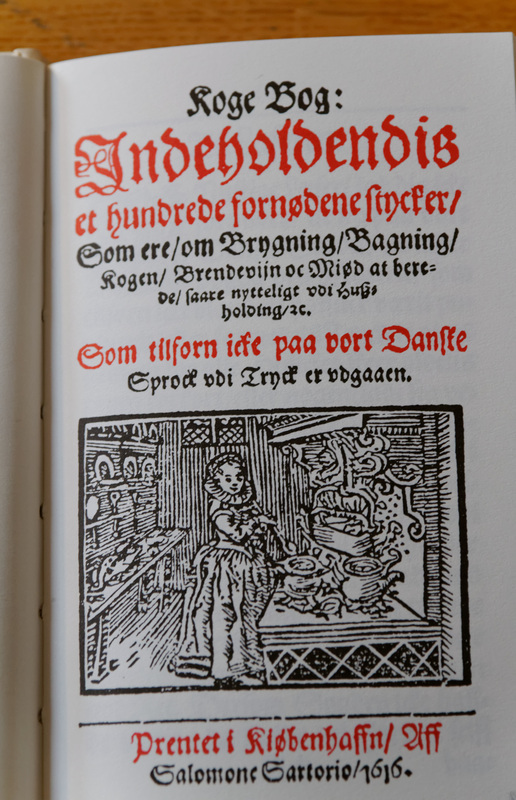
Danish cookbook, frontispiece |
Let's look at one example, the first Danish cookbook. It was published in Danish in 1616, based on earlier German works. The first recipe is for bread, the second for beer, and that recipe doesn't say you should add yeast. It takes for granted that you already know that. What it does say is (my translation from the original Danish):
When you pitch the yeast, then take good care that you do not add it too hot or too cold, but when it is somewhat more than milkwarm.
And there is no question that yeast is meant, because the word used is "gierd", easily recognizable as today's Danish "gær". Literally it says "naar du setter gierd paa," which is interesting, because farmhouse brewers in both Denmark and Norway used "å sette gjær på" as the phrase for pitching yeast into the 20th century.
Note the context here carefully. In 1616 adding yeast to beer was such an obvious thing that the recipe doesn't even bother to say it. And not only that, but there already exists a word for yeast in Danish, and even a set phrase for pitching it into beer.
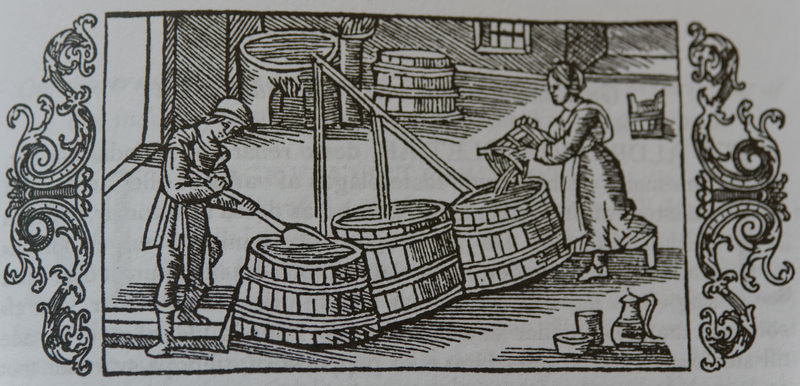
Medieval brewing, woodcut from Olaus Magnus's book |
If we look at other sources from the same period we find exactly the same thing. Olaus Magnus, 1555, says to use "the dregs from the previous beer." Cristoph Kobrer, 1581, has a whole chapter on how to reuse yeast, both dried and wet. Andrew Boorde, 1542, says that apart from malts and water one should never add anything to beer, except "yest, barme, or goddesgood", three synonyms for yeast.
In other words, by the 16th century, all over Europe, adding yeast to beer was just as common as it is today. Whenever it was that human beings figured out that they could add yeast to beer, it must have been long before the 16th century. But when?
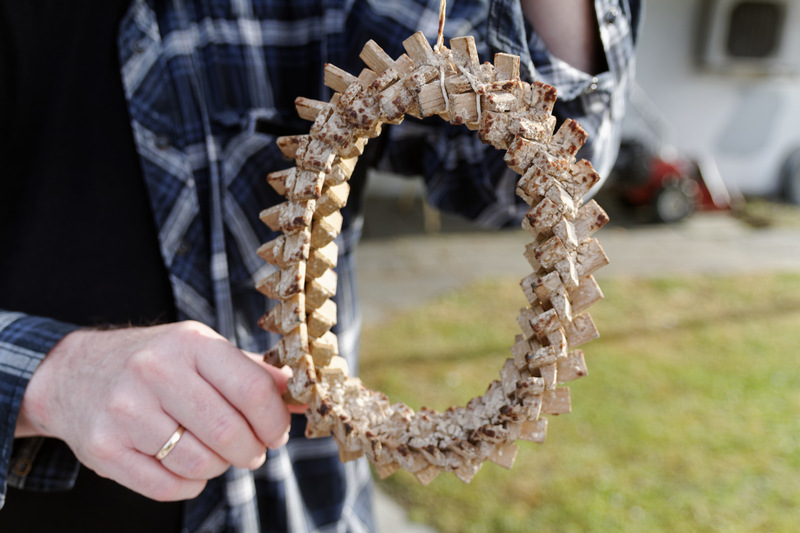
Sigmund with the yeast ring |
Let's start with a little basic logic. Sigmund showed me how to use a yeast ring. You drag it through the yeast (either the foam or the slurry) so that it sticks to the ring, then hang it up to dry. When you want to use it, take a little wort and drop the ring into it. That's it. That's literally all you need to successfully reuse yeast. And from archive documents I see that people also used cloth, wooden branches, or even straw rings, seemingly with no problems at all.
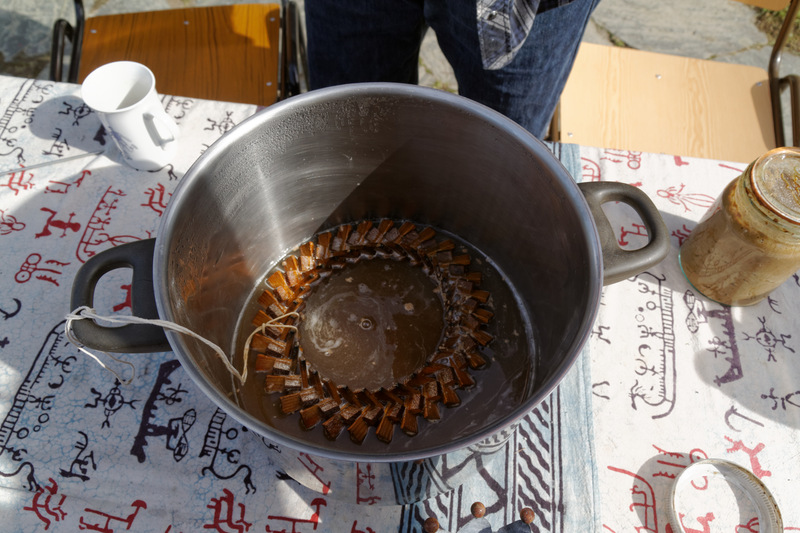
Yeast ring in wort (at 10:09) |
So people have had everything they needed to reuse yeast since the Stone Age. The only thing that was needed was to come up with the idea of taking the foam or the dregs from one beer, and putting it into the next. All you need to do is to think "what if I take some of the foam and put it in another beer? Will that make it foam?" It's a simple thing to try, and it obviously works.
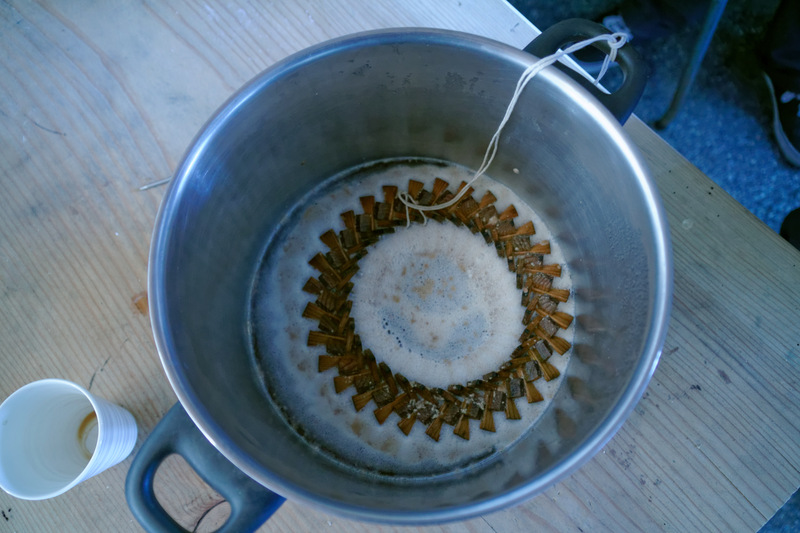
Yeast ring in fermenting wort (at 14:35) |
Not only that, but spontaneous fermentation starting from scratch is quite risky and can give all kinds of results. It can even be dangerous. So once someone came up with the idea of reusing the yeast from a successful brew it must have been blindingly obvious to everyone that this was a far better solution, and the method must have spread like wildfire.
Which still doesn't tell us when it happened.
In viking times, and also in prehistory, beer was brewed for specific celebrations. In fact, beer was so important for the main celebrations in life that to hold them without beer was unthinkable. In the guilds, for example, people would gather from a large area, brew beer, and have a feast a couple of days later.
Anders Christensen pointed out that if they were using spontaneous fermentation this would be pretty risky, because there would be no guarantee that the brew would be drinkable. It could also take a long time to start fermenting, yet there were strict deadlines involved.
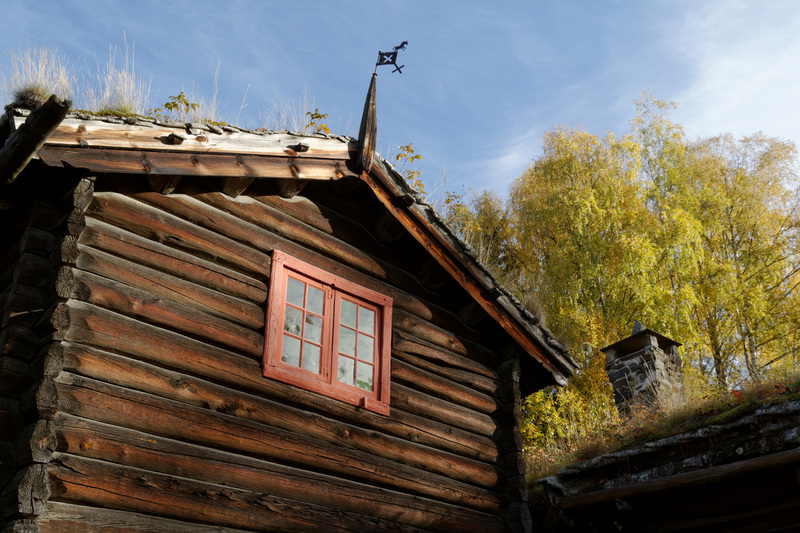
Old Norwegian farmhouse, Lillehammer museum |
Similarly, on the farms brewing consumed valuable grain. If many of the brews turned out bad that would be a highly costly proposition. In the 19th century Norwegian farmers usually brewed 2-3 times a year because they didn't have enough grain to brew more often. Yet in the viking era, and also before, every farm brewed. It's clear that somehow they were able to consistently produce good beer, and to do it quickly.
So, logically one would expect that the reuse of yeast began long, long before the 16th century. But can we prove it? Yes, actually, we can.
One early "recipe" that's often referred to as being written by Zosimus of Panopolis was actually not written by him. He lived in the 3rd and 4th centuries CE, long before the printing of books. So his works survive in manuscripts that were copied by hand, and in one of these chains of copies a kind of beer recipe appears that wasn't present in the original manuscript. The insertion is from around 1000 CE.

Distillation equipment, drawing from a manuscript by Zosimus |
The recipe says very clearly: "Grind the remainder and make [it] into loaves, adding yeast as that for bread." The text is in Greek, and the word used for yeast is ζύμη, "zyme". That still means yeast in modern Greek, and is the origin of the words "zymology" and "zymurgy". But this is an ancient text, so can we be sure that the word meant the same thing then? Here's Max Nelson, professor of Roman history, in his PhD on beer in classical civilization: "The usual Greek term for yeast was ζύμη and the Latin one was fermentum." So, yes, we can.
And we have older sources as well. Pliny the Elder writes in 77 CE of the Iberians (Spanish) and Gauls (French) that they take the foam from fermenting beer and use it in bread, so that they have lighter and better bread than other peoples. It's very difficult to believe that they did this without also having figured out the far more obvious idea that this works for making beer, too.
Max Nelson's PhD is basically a collection of all the quotes relating to beer from all historical Greek and Roman sources, organized by subject. If we look at yeast we find this:
In one account of a beer-maker from the first century A.D. preserved on a papyrus from Tebtunis mention is made of "pitchers of yeast" [...], which tends to show that a leavened liquid was added to ferment the beer. In Greco-Egyptian papyri of the first and second centuries A.D. there is also found the profession of "yeast-maker" or "zymonrgos". This cumulative evidence tends to show that at least by the first century A.D. there were individuals skilled in the breeding and cultivation of yeasts for both bread and beer.

Model of Egyptians brewing, Rosicrucian Egyptian Museum, San Jose, California. (E. Michael Smith, Wikimedia) |
So, what the documentary record shows is exactly what simple logic told us we should expect to find.
And there's no indication here that the reuse of yeast began around the first century CE. Nelson quotes sources from Egypt, but Pliny was talking about Spain and France. So clearly by this time the use of yeast was established practice over a very large area. It's entirely possible that the reuse of yeast is nearly as old as beer brewing itself, but so far the evidence for that, or against, is missing.
Delwen Samuel looked at dried-up residues of fermenting beer, from Amarna in Egypt. They date from around 1080 to 1550 BCE. Studying the residue under an electron microscope, she found what was clearly dried-up yeast cells. That was very likely Saccharomyces cerevisiae. However, this doesn't prove that the yeast was added deliberately, because even spontaneously fermenting beer is mostly fermented by that yeast. So pinpointing when yeast reuse began is going to be very difficult.

Ruins of Deir el-Medina, Egypt. (Steve F-E-Cameron, Wikimedia) |
Sources
Natural History, Pliny, 77 CE. Book XXIII, chapter XII.
Koge Bog, indeholdendis et hundrede fornødene Stycker, anonymous author, Copenhagen, 1616.
Beer in Greco-Roman Antiquity, Max Nelson, PhD thesis, University of British Columbia, 2001.
Gründliche und Nütze Beschreibung der Weinhawer und Bierbrewer-Practick und der ganzen Kellermeister-Kunst, Christoph Kobrer, 1581.
Historia de Gentibus Septentrionalibus, Olaus Magnus, 1555.
A compendyous regyment or a dyetary of healthe, Andrew Boorde, 1542.
Archaeology of Ancient Egyptian Beer, Delwen Samuel, Journal of the American Society of Brewing Chemists, 54(1), p3-12, 1996.
Acknowledgements
Many thanks to Susan Verberg for sending me a translation of Cristoph Kobrer. Also many thanks to Max Nelson for giving me more background on the Zosimus recipe.
Similar posts
Was all beer sour before Pasteur?
It's often said that before Pasteur's work on yeast (and Emil Christian Hansen's introduction of the pure-yeast system) all beer was sour
Read | 2014-10-26 18:01
Celtic Beer Yeast and Blue Cheese
A recent archaeological find caused much stir and writings in various newspapers, but everyone seems to have missed the most interesting part of the discovery
Read | 2021-11-01 08:59
Nordic grog
The origins of beer brewing in Scandinavia are lost in the mists of pre-history, and today we have very little evidence of how it began
Read | 2015-02-09 20:44
Comments
Kyle - 2018-04-29 23:56:07
Wonderful, as always.
You have mentioned yeast flakes a good few times here on the site and I was courious on the method used to produce them. How is it separated from the fermented beer? How is it dried and stored? After making a juniper raw ale, that pleasantly provided a dinner party with drinks, I dried the yeast as an experiment. Admittedly, I was flying blind, but at the very least it did strike me as an easy way to introduce bacteria.
Lastly, have you seen any examples of historic breweries and bakeries sharing yeast? If beer was infrequently brewed in an area the bakery would certainly have been convenient. It strikes me that I now remember reading an old mead recipe that suggested something similar. Although, if the ring or flakes or dregs could keep the yeast viable long enough for the next batch this may not have been needed.
Martyn Cornell - 2018-04-30 04:55:18
Walter of Bibbesworth certainly mentions yeast in the section of his Treatise from circa 1250 on brewing: unfortunately the most easily available source for Walter's words on brewing, Bickerdyke's Curiosities of Beer and Ale, is based on the T manuscript, which doesn't contain the relevant lines (and that's the version I based a blog post on nine years ago, curses, because that post is totally wrong …) The G manuscript says, in the bit that talks about 'geeste' or 'berme':
Puis serra le brez molu
E de eauwe chaude bien enbu.
Hors de keverel(1) meintenaunt
Taunt cum la bresceresce(2) entent
Ki ele eit bersil(3) a talent,
E puis le berzize(4) prendra
De forment ou orge ki ele a,
E par le geeste(5) e le berzille
Dunt home plus se sutille,
Par dreit dever de bracerye.
When the malt is ground and well steeped in hot water;
You let it drain sufficiently, now outside the mash-tub(1),
Until the brewster(2) knows she has enough wort;
Then she’ll take the grout that she has, of wheat or barley.
And with the yeast(5) and wort that people use so cleverly
In the proper process of brewing
(1) glossed in the surviving manuscript G as ‘mahissing fate’, ie mashing vat or mash tun; clearly linked to ‘kieve’
(2) more properly ‘maltsteress’: Bibbesworth differentiates between ‘brescer’, to malt and ‘brasser’, to brew
(3) glossed in the surviving manuscript G as ‘wort’
(4) glossed in the surviving manuscript G as ‘grout’.
(5) glossed in the surviving manuscript G as ‘berme’, ie barm in modern English, ie yeast
Lars Marius Garshol - 2018-04-30 06:23:14
@Kyle: Thank you!
Yeast flakes are made by taking some of the slurry (either from the foam, or from the bottom) and smearing it on baking parchment. Dry it in the oven at 30C, or in a clean room. Then just crumple the paper, and the flakes fall out. Apparently the bacteria are not very good at drying. In any case, it clearly works well.
One example is that breweries in 18th century Copenhagen were required by law to give the bakeries yeast for free. So bread yeast was produced by brewing. Baking doesn't produce any yeast.
Lars Marius Garshol - 2018-04-30 06:25:49
@Martyn: Thank you very much for this! That's very useful.
I was a bit puzzled at first as to what the glosses were, but I see now that he wrote his Treatise in French, with the glosses as a learning aid. Interesting that he uses what seems like a Dutch word for yeast in the French.
Bruce Denney - 2018-04-30 07:27:06
I have often thought about yeast in times before we could create sterile conditions and how people would maintain strains.
Do you know of honey being used to clean yeasts?
Honey has been fermented for a long time, and it doesn't make a lot of sense, honey is a really valuable product, why waste it?
Honey is also antibiotic and I have wondered if the brewing of honey was in part about cleaning up yeasts so the beer would taste better.
qq - 2018-04-30 15:14:55
While I have some scepticism about the exact dates published by Gallone - both from a what-makes-sense-from-history perspective and my understanding of the assumptions they've used for calibrating their clock - I don't think they're that far off. My personal suspicion is that it's tied up with the spread of hopped beer, in particular it feels like there were some breakthroughs in hop breeding somewhere in the Low Countries which may correspond to the emergence of the whitebine lineage in maybe the late 15th century. Then you had the chaos of the Reformation which led to huge numbers of religious refugees moving around Europe, bringing new ideas (and fungi and plant varieties) with them.
But Gallone et al are not saying that there was no beer-specific yeast before 1600, merely that the families we use today started diverging at that time. In phone terms, Beer 1 and 2 are the equivalent of iPhone and Android, most phones today are one or the other and which date to ~2007/8. But that doesn't mean there was no mobile phones before 2007/8, it just means that Siemens and Motorola etc couldn't compete with iPhone and Android. To extend that analogy, I guess that means that your kveiks and Baltic yeasts are the Nokia and Ericssons of yeast! They have a long history but are now a minor part of the ecosystem in volume terms albeit contributing a lot to its diversity.
Whilst we're on the subject of yeast origins, the 1002 Genomes project of the Schacherer and Liti labs have finally published their (1011!) sequences at www.nature.com/articles/s41586-018-0030-5, which seems to put the origins of Saccharomyces in Eastern China with multiple domestication events after that. They gave a not-particularly helpful chart of the relationships but Suregork has thrown their sequences at a Big Computer and combined them with the Gallone sequences : http://beer.suregork.com/?p=4000 Beer 1 at 11 o'clock in the main group of "brewery" yeasts - UK, US, abbey and kolsches, the mixed group to the left includes the bread yeasts, some whisk(e)y yeasts and a few weird beer yeasts like S-33/Windsor/Danstar ESB (all very closely related) and T-58, and then the bottom half of the chart are the "seasonal" yeasts - wine and the saisons (which also include some northern English brewery yeasts). The Strasbourg work isn't perfect - they seem to have mixed up the Orval and Artois yeasts, and gawd knows what they mean by Safale S40 as it doesn't look like anything we know about S-04. Combining the two has highlighted that eg one component of Nottingham does indeed seem to correspond to WLP039 East Midlands as had been suspected.
qq - 2018-04-30 15:20:19
@Bruce Denney - I doubt many people here would call making alcohol a waste of honey!
And initially I guess it would have been a special drink for religious and ritual reasons to "connect with god", a bit like the way shamans get high on various drugs.
There's still a link to ritual use of mead in the connection with weddings, hence "honeymoon".
Ingo - 2018-05-01 06:58:01
Look at the traditional brewing methods in Afrika, for example Choukachou from Benin. Leave the residue in the 'pot' to dry in the sun and reuse it in an other brew.
Lars Marius Garshol - 2018-05-01 08:56:22
@Bruce: I've never heard of anyone (outside of scientific brewing) cleaning yeast at all. Since yeast was something everyone had, if your yeast went bad you would simply get fresh yeast from someone else instead.
I think the reason honey was so highly valued was that it was a rare source of sugar. So honey was an easy way to make stronger beer, or just alcohol, or to sweeten things. Before 1800 there weren't really that many alternatives to honey available.
@qq: Something major definitely did happen to beer brewing in Northern Europe 1200-1400, but I think that has more to do with the discovery of hops and wort boiling than anything to do with yeast. Basically because as the blog post shows, yeast reuse was well known long, long before that era.
We can discuss exactly what Gallone et al claimed. I read them as saying that domestication began around the time that they calculated. Obviously, I disagree.
Thank you so much for the link to the Suregork blog post! I obviously need to subscribe to that blog so I don't keep missing stuff like this.
qq - 2018-05-01 13:46:05
@Lars Gallone et al are only making claims _for the strains they studied_, which they are very careful to say represent "today’s industrial yeasts". In phone terms, they're looking around at the "species" that dominate the market today, then tracing back and finding that iPhone and Android were "domesticated" in 2007/8 - they're not saying that people weren't "reusing" Nokias and Ericssons before then.
I think it's really interesting trying to figure out what happened in the Middle Ages. Hops go much further back than that - there are records of who had to participate in gathering wild hops in Germany in the 800s, so it was obviously an organised "thing" as far back as then. I suspect it was the breeding of high-alpha hops (whitebines?) that led to beers being stable enough to travel, which allows you to have a trade in beer - and the development of largescale hop farming and importantly hop-drying that allows you to have a full-time brewery as opposed to just using the hops as soon as they are harvested. Without drying the hops become useless within a couple of days.
From a yeast evolution point of view, I think that move to full-time brewing is crucial. It gets away from seasonal brewing/winemaking which as described above is dependent on drying yeast over summer (unless you're storing yeast under beer), and it also means evolution speeds up as you have many more generations per year.
The requirement to survive drying cuts you off from a big chunk of potential yeasts, as some really don't like it. Even with modern drying technology, Lallemand have really struggled to maintain viability for dry Conan for instance (the commercial packs are rated at 20% of the viable cells of their other strains and they still haven't released retail packs). So in a seasonal brewery, you would just not have the opportunity to brew with Conan.
The big question is what is the event equivalent to "smartphones" in the yeast world, what caused "iPhone" and Android to dominate over "Nokia" and "Ericsson"? I'd agree with you, I think part of it was the "Solitaire" effect - Microsoft Solitaire became the biggest computer game in the world not because it was the best, but because it was packaged with Windows. So when the Dutch trader sells you your first hops to make New Friesland IPA, the hot new style of beer, he would also strongly recommend that you use the Barbarian strain of goddesgood, no other yeast would give the same results.
But at the same time there are steps to yeast domestication which make some yeast better than others, good enough to displace what came before - POF-, maltotriose utilisation, alcohol tolerance (probably the biggest single requirement??) and to a lesser extent floccing. The evolution of strains with some or all of these characteristics is also a part of the story.
Dan - 2018-05-06 19:30:20
From the icelandic sources there are at least a couple of descriptions of yeast:
From Hálfs saga ok Hálfsrekka, chapter 1: Two women competing on making the best beer: "Ţćr kepptust um ölgerđina. Signý hét á Freyju, en Geirhildr á Hött. Hann lagđi fyrir dregg hráka sinn ok kveđst vilja fyrir tilkvámu sína ţat, er var milli kersins ok hennar. En ţat reyndist gott öl" hráki= saliva
•Jónsson, Guđny 1944: Fornaldarsögur Norđurlanda, bind 2. Reykjavik: Bókaútgáfan forni
From Jarteinabók Ţorláks byskups in forna chapter 8: "En er kveykvur váru lagđar undir mungátsefni ok allt vandliga til búit ţá gerđi eigi viđ taka, ok váru kveykurnar ónýtar raunar" kveykar= gjćr
•Egilsdóttir, Ásdís 2002: Biskupa sögur, Bind 2. Reykjavík: Hiđ íslenzka fornritafélag
Dan - 2018-05-06 20:24:07
Yeast is also called jöstr in Norse. The poet Kórmakr Ögmundarson calles beer or mead "jást-Rín", "yeast river" (Rín is the famous Rhine river) in his poem Sigurđardrápa from ca 960 AD. Snorri Sturlusson kalles it "jastar röst" (yeast current" in his poem Háttatal from the 13th century.
Lars Marius Garshol - 2018-05-08 18:01:34
@Dan: Thank you so much for this! I can't believe I didn't discover this before. That's very useful.
Roar Sandodden - 2018-05-09 13:14:34
And as you probably know Lars Marius, Jester is still used for yeast by some old people in Stjřrdal
Lars Marius Garshol - 2018-05-09 13:40:35
@Roar: Yes. In fact, "jest(er)" was the most common dialect word for yeast in Norwegian. So ... yes, the modern terms line up almost perfectly with these quotes.
Even the phrase "lagđar undir", to "lay down" the yeast, is highly reminiscent of phrases that were used for pitching yeast in the 20th century.
Martyn Cornell - 2018-05-11 11:39:12
@qq - 'There's still a link to ritual use of mead in the connection with weddings, hence "honeymoon"' - myth, I'm afraid. the origins of “honeymoon” are actually rather cynical: to quote one of the early references in the Oxford English Dictionary (from 1656): “Hony-moon, applyed to those marryed persons that love well at first, and decline in affection afterwards; it is hony now, but it will change as the Moon.”.
@Dan – I wonder if I could possibly ask you for a translation for all us ignorant types who don't <em>tölum íslensku</em>
Lars Marius Garshol - 2018-05-13 14:08:55
@Martyn: I contacted Eirik Storesund, who runs the Brute Norse blog https://www.brutenorse.com/ to get some input, and he sent a translation.
Second quote: "And when the kveik was placed into the mungĺts-piece (almost untranslatable: thing suitable for being turned into mungĺt (beer), which is to say wort) and everything had been labouriously prepared, then the fermentation did not begin, and the kveik proved to be useless."
The first quote is from a miracle performed by St Torlak. A woman fails to get her beer to ferment, so she prays to the saint, and (as the quote says) "then good and sufficient fermentation started right away, and it turned into the best mungĺt."
Dan - 2018-05-13 20:01:35
I can approve the translation of the second quote. The first quote is not a miracle performed by St. Torlak (this is he second quote). My translation: "They competed in beermaking. Signý prayed to Freyja (the love godess) and Geirhildr to Hött (Óđinn). He (meaning Óđinn) used his saliva as yeast and asked to get what was in between her and the "ker" (the wooden tub where the fermentation happens) as a payment. It proved to be good beer".
The thing between Geirhildr and the ker later proved to be a baby, she was pregnant.
Dan - 2018-05-18 19:52:59
@Lars Marius
Have you seen the word "dregg" used in any of your norwegian sources from the olden days? It has at least survived in modern Icelandic as a word for yeast. In plural (dreggjar) it means bunnfall, berme (sorry dont know the English translation for these words).
Lars Marius Garshol - 2018-05-21 13:33:22
@Dan: Unfortunately, no, I haven't seen that anywhere. I checked Ivar Aasen's dictionary, but the only meaning recorded there is for a small boat anchor. I bet this word is the origin of modern English "dregs", meaning exactly "bottom sludge."
Alice - 2018-05-29 00:06:16
Got here after reading your article on raw beer in Lithuania, so enlightening, thanks so much.
Alice - 2018-05-29 00:10:56
Reusing yeast probably has no definite origin; the concept of 'paying it forward' which is basically what you're doing when reusing yeast is something present in all cultures going back to the beginning if civilisation.
John - 2018-06-11 11:14:30
@qq Yeast are naturally programmed to survive drying in the wild. It might be the industrial method itself that causes problems for dry brewer's yeast manufactures. I like the phone analogy, btw.
@Alice I agree. I struggle to imagine how our superstitious ancestors, going back thousands of years, couldn't have noticed the magical result of repitching.
Given yeast were only recognised in 1857, as the living microbes responsible for fermentation, perhaps these older phrases for 'yeast' were describing something else. Something supernatural? A powerful spirit?
Lars Marius Garshol - 2018-06-11 11:17:25
@John: The etymology of the words for yeast generally lead in the direction of "being alive", "moving", "foam". There's surprisingly little sign of any mysticism or superstition surrounding the yeast itself. Around brewing in general there's been massive superstition, but not around the yeast itself.
John - 2018-06-11 12:44:55
Etymology isn't a science, Lars. Even if it were it would be confused by mass illiteracy, historically. It's more of an art. For example, gćst/gast/jäst/etc (guest) could be viewed in the context of a spiritual visitor, inoculating the brew with his magic. It's open to interpretation. A bit like runology and the embellishment of abstract runic inscriptions.
Lars Marius Garshol - 2018-06-11 12:49:38
@John: Of course not, but as far as I know this is all the evidence we have. If you want to argue that the meaning of "these older phrases for 'yeast'" you'll need some evidence.
John - 2018-06-11 13:57:36
So, it's a case of 'if it fits the story, we'll accept it', 'if it doesn't, we'll reject it'? I believe it's you who needs some evidence, Lars. Your synthesis is based on a survey done in the 1960s and a couple historical references. Can you demonstrate that kveik cultures used today compare with what brewers used in Norway 100, 200 even 300 years ago? As it stands, it's very romantic. Based on my knowledge of natural history, and my understanding of how these cultures have been managed, I suspect what you have is a collection of wild yeast, partly domesticated at best. Note ethanol production and flocculation are wild type traits. And POV -ve isn't necessarily indicative of yeast domestication. Some domesticated strains are POV +ve. Yes, I read the non-peer reviewed paper published online several months ago. If you get to sequence these kveik genomes (and I hope you do) and they turn out to occupy 'a unique branch on the ale tree', I suspect that would have more to do with wild yeast contamination and horizontal DNA transfer more than anything else. Including some local wild isolates might prove to be informative, in terms of interpreting the data.
Lars Marius Garshol - 2018-06-11 15:46:35
@John: Let's assume you are right. How did all the brewers along the west coast of Norway end up with yeast strains that are (a) all closely related to each other, and (b) have phenotypes exquisitely adapted to their way of brewing?
There's another piece of evidence as well. You'll see when the next version of the paper comes out.
John - 2018-06-11 16:58:29
I don't think I need to answer 'a', Lars. Think 'geography'.
As for 'b', yeast cultures can adapt/evolve very quickly, even 'pure' cultures are heterogeneous therefore prone to drift, which is why they are unlikely to compare with what was pitched generations ago. Unless they are replenished by local wild populations. A bit like traditional wine yeasts, in some respects. The 'yeast rings' are artificial habitats (sinks), being colonised from local sources. If any look similar to Europe's domesticated strains, they were probably introduced and went feral, like 'Muri'.
So when is the new evidence being published? And what makes it different from the 'stamp collecting' offered so far?
Lars Marius Garshol - 2018-06-11 17:13:23
@John: Thanks, but I've had enough of your condescending, snooty tone now. As far as I'm concerned this conversation is now at an end.
John - 2018-06-11 18:41:29
Was that an unfortunate display of Janteloven, Lars? Where I come from it's called contructive criticism.